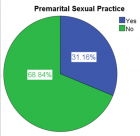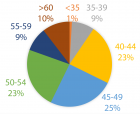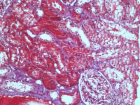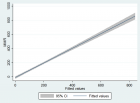About University of Uyo
University of Uyo
Articles by University of Uyo
Use of Hand Rehabilitation Board (Dominic’s Board) in Post Traumatic/Stroke Rehabilitation of the Upper Limbs
Published on: 31st May, 2017
In recent years, the increasing number of patients with upper limb musculoskeletal disorders seeking timely, intensive, prolonged and task oriented hospital- and home- based physical rehabilitation, and the decreasing numbers of trained therapist to provide the needed care, have left a palpable gab. These have resulted in several preventable deformities with associated complications leading to social and economic burdens. Although the introduction of some robotic devices has addressed some of these concerns, the shortfalls from the use of these devices limit their effectiveness. The newly introduced hand rehabilitation board (Dominic’s Board) was prospectively evaluated in 82 patients with ULMDs of different etiologies to assess its therapeutic efficacy in rehabilitation of ULMDs. Additive, but complementary effect was observed when used along with conventional hospital-based therapy and at home, suggesting the effectiveness of this device in preventing or ameliorating the complications associated with ULMDs.
Changes in Serum Markers of Atherogenesis and Hematological Profile after the consumption of Quail eggs
Published on: 10th May, 2017
OCLC Number/Unique Identifier: 7286423137
Previous studies suggest that diets with more eggs than is recommended may be used as part of a healthy diet in some countries. However, whether quail egg diets could form part of such diet has not been explored. The aim of the present study is to evaluate the effect of quail egg consumption on serum markers of atherogenesis and hematological parameters in healthy volunteers. Thirty adult subjects participated in this study after ascertaining their baseline health status. They were fed 3 eggs per day and 8hourlyfor 30 days. They were evaluated for serum levels of cholesterol sub-fractions, AIP and hematological parameters at days 0, 10 and 30 after the consumption of quail eggs. At day10, serum levels of cholesterol sub-fractions (TG, HDL-C and LDL-C) were not significantly (p>0.05) different from the corresponding values at baseline. Serum levels of VLDL-C and calculated AIP significantly (p<0.05) decreased compared to the levels at baseline. At day 30, serum levels of HDL-C, TG and VLDL-C significantly (p<0.05) increased, while LDL-C and AIP significantly decreased. Also, total RBC, HB, PCV, MCV, MCH and MCHC were not significantly different from the levels at baseline. At day 30, RBC, PCV and HB significantly (p<0.05) increased compared to the levels at baseline, while MCV, MCH and MCHC were not significantly (p>0.05) different from the baseline values.
Indeed, long-term consumption of quail egg may be associated with improvement in serum markers of atherogenesis and hematological parameters due to its varied nutrient constituents and their activities.
Micronutrient deficiency, a novel nutritional risk factor for insulin resistance and Syndrom X
Published on: 30th November, 2018
OCLC Number/Unique Identifier: 8465489491
Emerging evidence indicates that micronutrient deficiency could play a significant role in the pathogenesis and progression of many chronic diseases including diabetes mellitus, hypertension, obesity, dyslipidemia, hyperuricemia, kidney disease, cancer, anemia and other cardio-metabolic and neurodegenerative diseases through the induction of Insulin resistance (IR). However, there are still gaps in our scientific knowledge regarding the links between micronutrient deficiencies, IR, and cardio metabolic disorders. This review provides current information on recent advances and a global perspective regarding the relationship between micronutrient deficiency, IR, and cardio metabolic disorders. Empirical evidence indicates that deficiencies in either micronutrients associated with insulin activity (such as Chromium, manganese, magnesium, and iron) or antioxidant enzyme cofactors (such as vitamin A, copper, zinc, and manganese) could impact several physiological processes leading to a cascade of metabolic and biochemical derangements such as B-cell apoptosis, loss of islet cell mass, defective tyrosine kinase activity, oxidative stress, pancreatic β-cell dysfunction, reduction in lean body mass, defective insulin signaling mechanism, elevated protein kinase C activity, and excess intracellular calcium. Collaboratively, these states of metabolic malfunctioning are associated with IR, which triggers the onset of many cardio metabolic diseases. Undoubtedly, the prevention of micronutrient deficiency may indeed ameliorate the incidence of IR and cardio-metabolic disorders in those at risk and in the general population.
Lemongrass tea consumption and changes in Acid-Base Balance and Electrolyte homeostasis
Published on: 31st December, 2018
OCLC Number/Unique Identifier: 7991709231
The consumption of dietary herbs and supplements may be associated with several physiological consequences including, but not limited to disturbances of acid-base homeostasis, minerals and electrolytes wasting, gastrointestinal disturbances as well as hemodynamic changes. Plants food based nutritional studies are important for assessing the effect of plants on human health and wellbeing. The aim of this study was to assess the changes in acid-base status and electrolyte homeostasis following the consumption of lemongrass tea. The acute and sub-chronic effects of infusions prepared from 2, 4, and 8g lemongrass leaf powder on serum and urinary pH, and electrolytes levels were assessed in 105 subjects using an interventional study design. The results post-treatment were compared with baseline values.
Plasma pH decreased from baseline value of 7.37 ± 0.02 to 7.20 ± 0.03, and 7.30 ± 0.02 at days 10 and 30 respectively for participants treated with infusion prepared from 2g of lemongrass leaf powder. For those treated with infusion prepared from 4g of lemongrass leaf powder, plasma pH decreased from baseline value of 7.35 ± 0.02 to 7.22 ± 0.02 and 7.29 ± 0.02 at days 10 and 30 respectively.
Treatment with infusion prepared from 8g of lemongrass leaf powder caused a decrease in plasma pH from baseline value of 7.38 ± 0.02 to 7.15 ± 0.02 and 7.18 ± 0.02 at days 10 and 30 respectively. Corresponding changes in urinary pH were also observed. Furthermore, at days 10 and 30, plasma protein concentrations increased significantly (p < 0.05) in subjects treated with infusion prepared from 8g lemongrass leaf extract. There were also significant increases (p < 0.05) in urinary volume, urination frequency, and urinary electrolytes levels within the same period.
The consumption of lemongrass tea may be associated with changes in acid-base balance and electrolyte homeostasis due to its varied biological constituents and their activities
Determinants of health seeking behaviour of women with obstetric fistula in south- south and south east, Nigeria: A review of the impact of availability and quality of health care services through a cross-sectional study
Published on: 4th May, 2021
OCLC Number/Unique Identifier: 9041186095
Background: Obstetric fistula is a condition that results from obstructed labour, which occurs when the baby cannot pass through the mother’s birth canal because it either does not come head first or is too large for her pelvis. Prompt medical intervention, often including Caesarean section, permits a safe delivery for both mother and child. Despite this possibility, yearly, thousands of women across the country receive no such aid and their labour is a futile agony lasting between three and five days, with uterine contractions constantly forcing the baby, usually head first, against the organs of the pelvic and unyielding pelvic bone resulting in Vesico Vaginal Fistula (VVF). The main thrust of this study was to examine how health system factors affect health seeking behaviour of women with obstetric fistula in Akwa Ibom and Ebonyi States, Nigeria.
Methods: Qualitative and descriptive research approaches were adopted for the study and a total sample of two hundred and sixteen (216) respondents comprising of one hundred and fifty (150) post fistula repair operative patients and sixty six (66) health workers were purposively selected using simple random techniques. The data were analyzed using thematic analysis and tables of frequency.
Results: The respondents views showed that availability of treatment centre and quality of health care services influenced health seeking behaviour of women with obstetric fistula in Nigeria.
Conclusion: The study indicated that health seeking behaviour of women with obstetric fistula is a major challenge in Nigeria. Establishment and proper equipment of obstetric fistula treatment centres as well as subsidization of the cost of treatment to allow women with this health problem to access health care services are strongly recommended. Therefore, government at all level and non-governmental organizations need to educate the women and create awareness on the causes and dangers of VVF.
A retrospective review of the factors that negatively influenced the eradication of polio in South-South, Nigeria
Published on: 30th July, 2021
OCLC Number/Unique Identifier: 9186964198
Background: The endemic nature of poliomyelitis in Nigeria was a source of concern to many given the global efforts aimed at eradicating the scourge. In this study, the factors that influenced the eradication of this malady in South-South Nigeria (Akwa Ibom and Cross River State) were investigated. Four null hypotheses, drawn on these factors (including culture belief, religious difference, language and the prevalence of ethnic conflict) guided the investigation.
The main thrust of this study was to examine how socio-cultural factors negatively influenced the eradication of polio in the study area.
Methods: Through stratified random and purposive sampling techniques, 600 adult men and women who had children were selected for the study. A structured questionnaire constructed by the researcher was used in data collection. Data analysis was carried out using one-way ANOVA and independent t-test statistical tools.
Results: The findings were that cultural belief and religious affiliation exerted significant influence on the people’s effort towards polio eradication.
Conclusion: The study indicated that the low use of health services by the people was brought about by variation in these variables. Among other things, it was suggested that continuous awareness campaigns be carried out to educate the people on the need for immunization anchored in science and technology.

If you are already a member of our network and need to keep track of any developments regarding a question you have already submitted, click "take me to my Query."




















































































































































